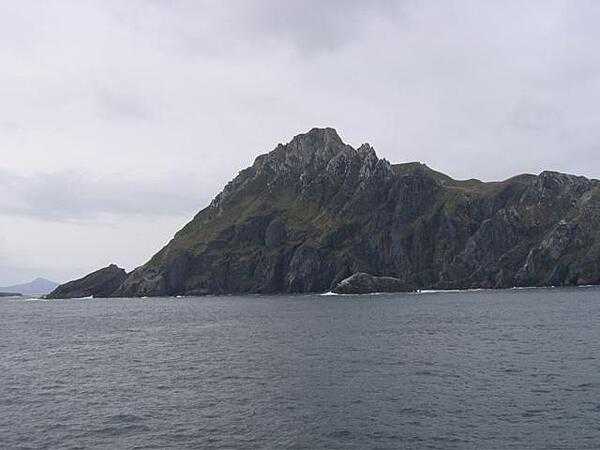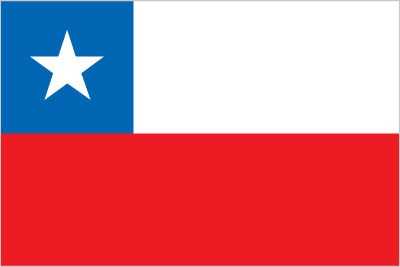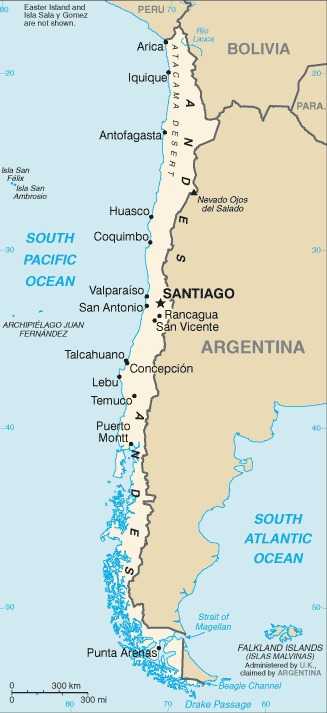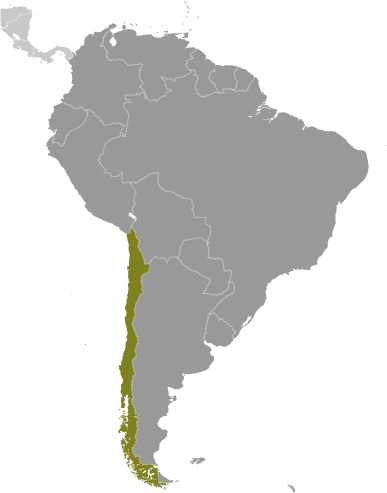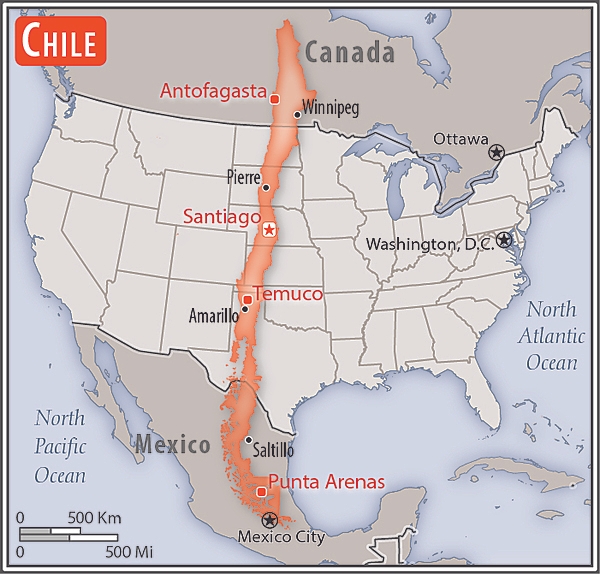Introduction
Background
Indigenous groups inhabited central and southern Chile for several thousand years, living in mixed pastoralist and settled communities. The Inca then ruled the north of the country for nearly a century prior to the arrival of the Spanish in the 16th century. In 1541, the Spanish established the Captaincy General of Chile, which lasted until Chile declared its independence in 1810. The subsequent struggle with the Spanish became tied to other South American independence conflicts, with a decisive victory not being achieved until 1818. In the War of the Pacific (1879-83), Chile defeated Peru and Bolivia to win its current northernmost regions. By the 1880s, the Chilean central government cemented its control over the central and southern regions inhabited by Mapuche Indigenous peoples. Between 1891 and 1973, a series of elected governments succeeded each other until the Marxist government of Salvador ALLENDE was overthrown in 1973 in a military coup led by General Augusto PINOCHET, who ruled until a democratically elected president was inaugurated in 1990. Economic reforms that were maintained consistently since the 1980s contributed to steady growth, reduced poverty rates by over half, and helped secure the country's commitment to democratic and representative government. Chile has increasingly assumed regional and international leadership roles befitting its status as a stable, democratic nation.
Visit the Definitions and Notes page to view a description of each topic.
Geography
Location
Southern South America, bordering the South Pacific Ocean, between Argentina and Peru
Geographic coordinates
30 00 S, 71 00 W
Map references
South America
Area
total : 756,102 sq km
land: 743,812 sq km
water: 12,290 sq km
note: includes Easter Island (Isla de Pascua) and Isla Sala y Gomez
comparison ranking: total 39
Land boundaries
total: 7,801 km
border countries (3): Argentina 6,691 km; Bolivia 942 km; Peru 168 km
Coastline
6,435 km
Maritime claims
territorial sea: 12 nm
contiguous zone: 24 nm
exclusive economic zone: 200 nm
continental shelf: 200/350 nm
Climate
temperate; desert in north; Mediterranean in central region; cool and damp in south
Terrain
low coastal mountains, fertile central valley, rugged Andes in east
Elevation
highest point: Nevado Ojos del Salado 6,893 m (highest volcano in the world)
lowest point: Pacific Ocean 0 m
mean elevation: 1,871 m
Natural resources
copper, timber, iron ore, nitrates, precious metals, molybdenum, hydropower
Land use
agricultural land: 21.1% (2018 est.)
arable land: 1.7% (2018 est.)
permanent crops: 0.6% (2018 est.)
permanent pasture: 18.8% (2018 est.)
forest: 21.9% (2018 est.)
other: 57% (2018 est.)
Irrigated land
11,100 sq km (2012)
Major lakes (area sq km)
fresh water lake(s): Lago General Carrera (shared with Argentina) - 2,240 sq km; Lago O'Higgins (shared with Argentina) - 1,010 sq km; Lago Llanquihue - 800 sq km; Lago Fagnano (shared with Argentina) - 590 sq km
Population distribution
90% of the population is located in the middle third of the country around the capital of Santiago; the far north (anchored by the Atacama Desert) and the extreme south are relatively underpopulated
Natural hazards
severe earthquakes; active volcanism; tsunamis
volcanism: significant volcanic activity due to more than three-dozen active volcanoes along the Andes Mountains; Lascar (5,592 m), which last erupted in 2007, is the most active volcano in the northern Chilean Andes; Llaima (3,125 m) in central Chile, which last erupted in 2009, is another of the country's most active; Chaiten's 2008 eruption forced major evacuations; other notable historically active volcanoes include Cerro Hudson, Calbuco, Copahue, Guallatiri, Llullaillaco, Nevados de Chillan, Puyehue, San Pedro, and Villarrica; see note 2 under "Geography - note"
Geography - note
note 1: the longest north-south trending country in the world, extending across 39 degrees of latitude; strategic location relative to sea lanes between the Atlantic and Pacific Oceans (Strait of Magellan, Beagle Channel, Drake Passage)
note 2: Chile is one of the countries along the Ring of Fire, a belt of active volcanoes and earthquake epicenters bordering the Pacific Ocean; up to 90% of the world's earthquakes and some 75% of the world's volcanoes occur within the Ring of Fire
note 3: the Atacama Desert -- the driest desert in the world -- spreads across the northern part of the country; Ojos del Salado (6,893 m) in the Atacama Desert is the highest active volcano in the world, Chile's tallest mountain, and the second highest in the Western Hemisphere and the Southern Hemisphere -- its small crater lake (at 6,390 m) is the world's highest lake
People and Society
Population
total: 18,664,652
male: 9,169,736
female: 9,494,916 (2024 est.)
comparison rankings: female 67; male 67; total 67
Nationality
noun: Chilean(s)
adjective: Chilean
Ethnic groups
White and non-Indigenous 88.9%, Mapuche 9.1%, Aymara 0.7%, other Indigenous groups 1% (includes Rapa Nui, Likan Antai, Quechua, Colla, Diaguita, Kawesqar, Yagan or Yamana), unspecified 0.3% (2012 est.)
Languages
Spanish 99.5% (official), English 10.2%, Indigenous 1% (includes Mapudungun, Aymara, Quechua, Rapa Nui), other 2.3%, unspecified 0.2%; note - shares sum to more than 100% because some respondents gave more than one answer on the census (2012 est.)
major-language sample(s):
La Libreta Informativa del Mundo, la fuente indispensable de información básica. (Spanish)
The World Factbook, the indispensable source for basic information.
Religions
Roman Catholic 42%, Evangelical 14%, other 6%, none 37% (2021 est.)
Demographic profile
Chile is in the advanced stages of demographic transition and is becoming an aging society - with fertility below replacement level, low mortality rates, and life expectancy on par with developed countries. Nevertheless, with its dependency ratio nearing its low point, Chile could benefit from its favorable age structure. It will need to keep its large working-age population productively employed, while preparing to provide for the needs of its growing proportion of elderly people, especially as women - the traditional caregivers - increasingly enter the workforce. Over the last two decades, Chile has made great strides in reducing its poverty rate, which is now lower than most Latin American countries. However, its severe income inequality ranks as the worst among members of the Organization for Economic Cooperation and Development. Unequal access to quality education perpetuates this uneven income distribution.
Chile has historically been a country of emigration but has slowly become more attractive to immigrants since transitioning to democracy in 1990 and improving its economic stability (other regional destinations have concurrently experienced deteriorating economic and political conditions). Most of Chile's small but growing foreign-born population consists of transplants from other Latin American countries, especially Peru.
Age structure
0-14 years: 19.2% (male 1,822,908/female 1,751,528)
15-64 years: 67.3% (male 6,274,620/female 6,278,467)
65 years and over: 13.6% (2024 est.) (male 1,072,208/female 1,464,921)
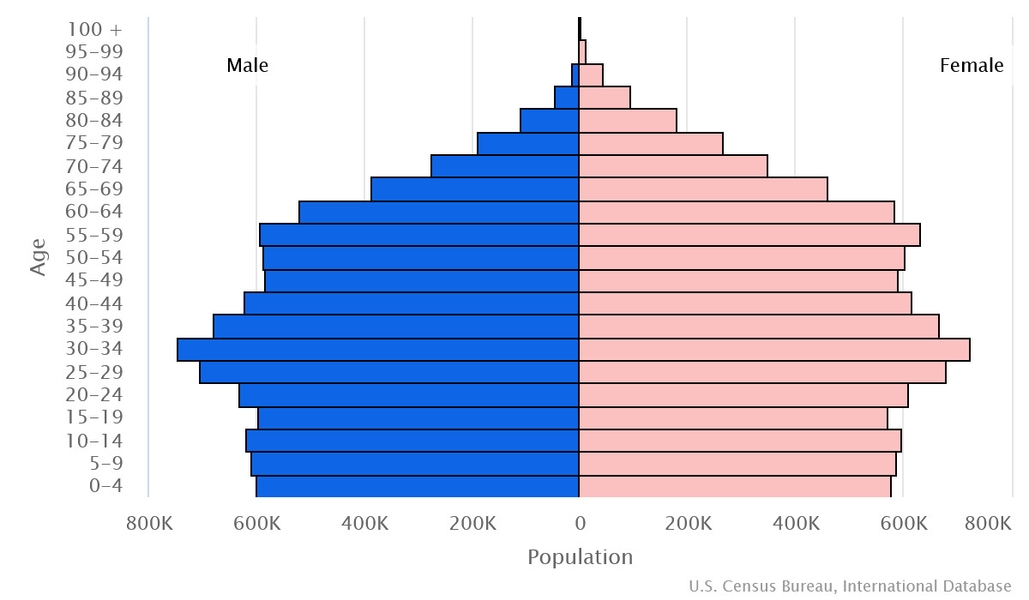
Dependency ratios
total dependency ratio: 45.2
youth dependency ratio: 26.8
elderly dependency ratio: 18.4
potential support ratio: 5.4 (2021 est.)
Median age
total: 36.9 years (2024 est.)
male: 35.8 years
female: 38.2 years
comparison ranking: total 85
Population distribution
90% of the population is located in the middle third of the country around the capital of Santiago; the far north (anchored by the Atacama Desert) and the extreme south are relatively underpopulated
Urbanization
urban population: 88% of total population (2023)
rate of urbanization: 0.78% annual rate of change (2020-25 est.)
Major urban areas - population
6.903 million SANTIAGO (capital), 1.009 million Valparaiso, 912,000 Concepcion (2023)
Sex ratio
at birth: 1.04 male(s)/female
0-14 years: 1.04 male(s)/female
15-64 years: 1 male(s)/female
65 years and over: 0.73 male(s)/female
total population: 0.97 male(s)/female (2024 est.)
Infant mortality rate
total: 6.3 deaths/1,000 live births (2024 est.)
male: 6.9 deaths/1,000 live births
female: 5.7 deaths/1,000 live births
comparison ranking: total 166
Life expectancy at birth
total population: 80.3 years (2024 est.)
male: 77.3 years
female: 83.3 years
comparison ranking: total population 55
Gross reproduction rate
0.85 (2024 est.)
Contraceptive prevalence rate
76.3% (2015/16)
Drinking water source
improved: urban: 100% of population
rural: 100% of population
total: 100% of population
unimproved: urban: 0% of population
rural: 0% of population
total: 0% of population (2020 est.)
Current health expenditure
9.8% of GDP (2020)
Physician density
2.84 physicians/1,000 population (2020)
Hospital bed density
2.1 beds/1,000 population (2018)
Sanitation facility access
improved: urban: 100% of population
rural: 100% of population
total: 100% of population
unimproved: urban: 0% of population
rural: 0% of population
total: 0% of population (2020 est.)
Alcohol consumption per capita
total: 7.8 liters of pure alcohol (2019 est.)
beer: 2.76 liters of pure alcohol (2019 est.)
wine: 2.61 liters of pure alcohol (2019 est.)
spirits: 2.43 liters of pure alcohol (2019 est.)
other alcohols: 0 liters of pure alcohol (2019 est.)
comparison ranking: total 47
Tobacco use
total: 29.2% (2020 est.)
male: 31.6% (2020 est.)
female: 26.8% (2020 est.)
comparison ranking: total 34
Currently married women (ages 15-49)
46.3% (2023 est.)
Literacy
definition: age 15 and over can read and write
total population: 97%
male: 97.1%
female: 97% (2021)
School life expectancy (primary to tertiary education)
total: 17 years
male: 16 years
female: 17 years (2020)
Environment
Environment - current issues
air pollution from industrial and vehicle emissions; water pollution from raw sewage; noise pollution; improper garbage disposal; soil degradation; widespread deforestation and mining threaten the environment; wildlife conservation
Environment - international agreements
party to: Antarctic-Environmental Protection, Antarctic-Marine Living Resources, Antarctic Seals, Antarctic Treaty, Biodiversity, Climate Change, Climate Change-Kyoto Protocol, Climate Change-Paris Agreement, Comprehensive Nuclear Test Ban, Desertification, Endangered Species, Environmental Modification, Hazardous Wastes, Law of the Sea, Marine Dumping-London Convention, Marine Dumping-London Protocol, Nuclear Test Ban, Ozone Layer Protection, Ship Pollution, Wetlands, Whaling
signed, but not ratified: none of the selected agreements
Climate
temperate; desert in north; Mediterranean in central region; cool and damp in south
Land use
agricultural land: 21.1% (2018 est.)
arable land: 1.7% (2018 est.)
permanent crops: 0.6% (2018 est.)
permanent pasture: 18.8% (2018 est.)
forest: 21.9% (2018 est.)
other: 57% (2018 est.)
Urbanization
urban population: 88% of total population (2023)
rate of urbanization: 0.78% annual rate of change (2020-25 est.)
Air pollutants
particulate matter emissions: 20.49 micrograms per cubic meter (2019 est.)
carbon dioxide emissions: 85.82 megatons (2016 est.)
methane emissions: 15.97 megatons (2020 est.)
Waste and recycling
municipal solid waste generated annually: 6.517 million tons (2009 est.)
municipal solid waste recycled annually: 24,113 tons (2009 est.)
percent of municipal solid waste recycled: 0.4% (2009 est.)
Major lakes (area sq km)
fresh water lake(s): Lago General Carrera (shared with Argentina) - 2,240 sq km; Lago O'Higgins (shared with Argentina) - 1,010 sq km; Lago Llanquihue - 800 sq km; Lago Fagnano (shared with Argentina) - 590 sq km
Total water withdrawal
municipal: 1.29 billion cubic meters (2020 est.)
industrial: 1.66 billion cubic meters (2020 est.)
agricultural: 29.42 billion cubic meters (2020 est.)
Total renewable water resources
923.1 billion cubic meters (2020 est.)
Geoparks
total global geoparks and regional networks: 1
global geoparks and regional networks: Kutralkura (2023)
Government
Country name
conventional long form: Republic of Chile
conventional short form: Chile
local long form: República de Chile
local short form: Chile
etymology: derivation of the name is unclear, but it may come from the Mapuche word "chilli" meaning "limit of the earth" or from the Quechua "chiri" meaning "cold"
Government type
presidential republic
Capital
name: Santiago; note - Valparaiso is the seat of the national legislature
geographic coordinates: 33 27 S, 70 40 W
time difference: UTC-3 (2 hours ahead of Washington, DC, during Standard Time)
daylight saving time: +1hr, begins second Sunday in August; ends second Sunday in May; note - Punta Arenas observes DST throughout the year
time zone note: Chile has three time zones: the continental portion at UTC-3; the southern Magallanes region, which does not use daylight savings time and remains at UTC-3 for the summer months; and Easter Island at UTC-5
etymology: Santiago is named after the biblical figure Saint James (ca. A.D. 3-44), patron saint of Spain, but especially revered in Galicia; "Santiago" derives from the local Galician evolution of the Vulgar Latin "Sanctu Iacobu"; Valparaiso derives from the Spanish "Valle Paraiso" meaning "Paradise Valley"
Administrative divisions
16 regions (regiones, singular - region); Aysen, Antofagasta, Araucania, Arica y Parinacota, Atacama, Biobio, Coquimbo, Libertador General Bernardo O'Higgins, Los Lagos, Los Rios, Magallanes y de la Antartica Chilena (Magallanes and Chilean Antarctica), Maule, Nuble, Region Metropolitana (Santiago), Tarapaca, Valparaiso
note: the US does not recognize any claims to Antarctica
Independence
18 September 1810 (from Spain)
National holiday
Independence Day, 18 September (1810)
Constitution
history: many previous; latest adopted 11 September 1980, effective 11 March 1981; in September 2022 and again in December 2023, referendums presented for a new constitution were both defeated, and the September 1980 constitution remains in force
amendments: proposed by members of either house of the National Congress or by the president of the republic; passage requires at least four-sevenths majority vote of the membership in both houses and approval by the president; passage of amendments to constitutional articles, such as the republican form of government, basic rights and freedoms, the Constitutional Tribunal, electoral justice, the Council of National Security, or the constitutional amendment process, requires at least four-sevenths majority vote by both houses of Congress and approval by the president; the president can opt to hold a referendum when Congress and the president disagree on an amendment; amended many times, last in 2022
Legal system
civil law system influenced by several West European civil legal systems; judicial review of legislative acts by the Constitutional Tribunal
International law organization participation
has not submitted an ICJ jurisdiction declaration; accepts ICCt jurisdiction
Citizenship
citizenship by birth: yes
citizenship by descent only: yes
dual citizenship recognized: yes
residency requirement for naturalization: 5 years
Suffrage
18 years of age; universal
Executive branch
chief of state: President Gabriel BORIC (since 11 March 2022)
head of government: President Gabriel BORIC (since 11 March 2022)
cabinet: Cabinet appointed by the president
elections/appointments: president directly elected by absolute majority popular vote in 2 rounds if needed for a single 4-year term; election last held on 21 November 2021 with a runoff held on 19 December 2021 (next to be held on 23 November 2025 with runoff if needed on 20 December)
election results:
2021: Gabriel BORIC elected president in second round; percent of vote in first round - Jose Antonio KAST (FSC) 27.9%; Gabriel BORIC (AD) 25.8%; Franco PARISI (PDG) 12.8%; Sebastian SICHEL (ChP+) 12.8%; Yasna PROVOSTE (New Social Pact) 11.6%; other 9.1%; percent of vote in second round - Gabriel BORIC 55.9%; Jose Antonio KAST 44.1%
2017: Sebastian PINERA Echenique elected president in second round; percent of vote in first round - Sebastian PINERA Echenique (independent) 36.6%; Alejandro GUILLIER (independent) 22.7%; Beatriz SANCHEZ (independent) 20.3%; Jose Antonio KAST (independent) 7.9%; Carolina GOIC (PDC) 5.9%; Marco ENRIQUEZ-OMINAMI (PRO) 5.7%; other 0.9%; percent of vote in second round - Sebastian PINERA Echenique 54.6%, Alejandro GUILLIER 45.4%
note: the president is both chief of state and head of government
Legislative branch
description: bicameral National Congress or Congreso Nacional consists of:
Senate or Senado (50 seats); members directly elected in multi-seat constituencies by open party-list proportional representation vote to serve 8-year terms with one-half of the membership renewed every 4 years)
Chamber of Deputies or Camara de Diputados (155 seats; members directly elected in multi-seat constituencies by open party-list proportional representation vote to serve 4-year terms)
elections: Senate - last held on 21 November 2021 (next to be held on 23 November 2025)
Chamber of Deputies - last held on 21 November 2021 (next to be held on 23 November 2025)
election results: Senate - percent of vote by party/coalition - NA; seats by party/coalition - ChP+ 12 (RN 5, UDI 5, EVOPOLI 2), NPS 8 (PS 4, PPD 2, PDC 2), AD 4 (PCCh 2, FREVS 2), PLR 1, independent 2; composition - men 37, women 13, percentage women 26%
Chamber of Deputies - percent of vote by party/coalition - NA; seats by party/coalition - ChP+ 53 (RN 25, UDI 23, EVOPOLI 4, PRI 1), AD 37 (PCCh 12, CS 9, RD 8, Commons 6, FREVS 2), NPS 37 (PS 13, PDC 8, PPD 7, PL 4, PRSD 4, CIU 1), FSC 15 (PLR 14, PCC 1), PDG 6, PH 3, PEV 2, IU 1, independent 1; composition - men 100, women 55, percentage women 35.5%; total National Congress percentage women 33.2% as of January 2024
note: Senate seats by party/coalition as of May 2022 - ChP+ 24 (RN 12, UDI 9, EVOPOLI 3), NPS 18 (PS 7, PPD 6, PDC 5), AD 6 (PCCh 2, FREVS 2, RD 2), PLR 1, independent 1;
Judicial branch
highest court(s): Supreme Court or Corte Suprema (consists of a court president and 20 members or ministros); Constitutional Court (consists of 10 members and is independent of the rest of the judiciary); Elections Qualifying Court (consists of 5 members)
judge selection and term of office: Supreme Court president and judges (ministers) appointed by the president of the republic and ratified by the Senate from lists of candidates provided by the court itself; judges appointed for life with mandatory retirement at age 70; Constitutional Court members appointed - 3 by the Supreme Court, 3 by the president of the republic, 2 by the Chamber of Deputies, and 2 by the Senate; members serve 9-year terms with partial membership replacement every 3 years (the court reviews constitutionality of legislation); Elections Qualifying Court members appointed by lottery - 1 by the former president or vice president of the Senate and 1 by the former president or vice president of the Chamber of Deputies, 2 by the Supreme Court, and 1 by the Appellate Court of Valparaiso; members appointed for 4-year terms
subordinate courts: Courts of Appeal; oral criminal tribunals; military tribunals; local police courts; specialized tribunals and courts in matters such as family, labor, customs, taxes, and electoral affairs
Political parties and leaders
Approve Dignity (Apruebo Dignidad) coalition or AD (included PC, FA, and FREVS); note - dissolved 2023
Broad Front Coalition (Frente Amplio) or FA (includes RD, CS, and Comunes) [Gonzalo WINTER]
Chile We Can Do More (Chile Podemos Más) or ChP+ (coalition includes EVOPOLI, PRI, RN, UDI)
Christian Democratic Party or PDC [Alberto UNDURRAGA Vicuña]
Common Sense Party or SC [Rodrigo CARAMORI Donoso]
Commons (Comunes) [Marco VELARDE Salinas]
Communist Party of Chile or PCCh [Lautaro CARMONA Soto]
Democratic Revolution or RD [Diego VELA Grau]
Democrats or PD [Ximena RINCON González]
Equality Party or PI [Iván CARRASCO Mora]
Green Ecological Party or PEV [Felix GONZALEZ] (dissolved 7 February 2022)
Green Popular Alliance or AVP [Carlos PICHUANTE Verdugo]
Humanist Action Party or PAH [Tomás HIRSCH Goldschmidt]
Humanist Party or PH [Claudio OJEDA Murillo]
Independent Democratic Union or UDI [Javier MACAYA]
Liberal Party (Partido Liberal de Chile) or PL [Juan Carlos URZÚA Pettinelli]
National Renewal or RN [Rodrigo GALILEA Vial]
New Social Pact or NPS [Yasna PROVOSTE] (includes PDC, PL, PPD, PRSD, PS)
Party for Democracy or PPD [Jaime QUINTANA Leal]
Party of the People or PDG [Luis MORENO Villablanca]
Political Evolution or EVOPOLI [Gloria HUTT Hesse]
Popular Party or PP [Cristián CUEVAS Zambrano]
Progressive Homeland Party or PRO [Ignacio BUSTOS Sáez]
Radical Party or PR [Leonardo CUBILLOS Ramírez]
Republican Party or PLR [Arturo SQUELLA Ovalle]
Social Christian Party or PSC [Sara CONCHA Smith]
Social Convergence or CS [Diego IBÁÑEZ Cotroneo]
Social Green Regionalist Federation or FREVS [Flavia TORREALBA Diaz]
Socialist Party or PS [Paulina VODANOVIC Rojas]
Yellow Movement for Chile or AMAR [Andrés JOUANNET Valderrama]
International organization participation
APEC, BIS, CAN (associate), CD, CELAC, FAO, G-15, G-77, IADB, IAEA, IBRD, ICAO, ICC (national committees), ICCt, ICRM, IDA, IFAD, IFC, IFRCS, IHO, ILO, IMF, IMO, IMSO, Interpol, IOC, IOM, IPU, ISO, ITSO, ITU, ITUC (NGOs), LAES, LAIA, Mercosur (associate), MIGA, MINUSTAH, NAM, OAS, OECD (enhanced engagement), OPANAL, OPCW, Pacific Alliance, PCA, PROSUR, SICA (observer), UN, UNASUR, UNCTAD, UNESCO, UNFICYP, UNHCR, UNIDO, Union Latina, UNMOGIP, UNTSO, UNWTO, UPU, WCO, WFTU (NGOs), WHO, WIPO, WMO, WTO
Diplomatic representation in the US
chief of mission: Ambassador Juan Gabriel VALDES Soublette (since 7 June 2022)
chancery: 1732 Massachusetts Avenue NW, Washington, DC 20036
telephone: [1] (202) 785-1746
FAX: [1] (202) 887-5579
email address and website:
echile.eeuu@minrel.gob.cl
https://chile.gob.cl/estados-unidos/en/
consulate(s) general: Chicago, Houston, Los Angeles, Miami, New York, San Francisco
Diplomatic representation from the US
chief of mission: Ambassador Bernadette M. MEEHAN (since 30 September 2022)
embassy: Avenida Andres Bello 2800, Las Condes, Santiago
mailing address: 3460 Santiago Place, Washington DC 20521-3460
telephone: [56] (2) 2330-3000
FAX: [56] (2) 2330-3710
email address and website:
SantiagoUSA@state.gov
https://cl.usembassy.gov/
Flag description
two equal horizontal bands of white (top) and red; a blue square the same height as the white band at the hoist-side end of the white band; the square bears a white five-pointed star in the center representing a guide to progress and honor; blue symbolizes the sky, white is for the snow-covered Andes, and red represents the blood spilled to achieve independence
note: design influenced by the US flag
National symbol(s)
huemul (mountain deer), Andean condor; national colors: red, white, blue
National anthem
name: "Himno Nacional de Chile" (National Anthem of Chile)
lyrics/music: Eusebio LILLO Robles and Bernardo DE VERA y Pintado/Ramon CARNICER y Battle
note: music adopted 1828, original lyrics adopted 1818, adapted lyrics adopted 1847; under Augusto PINOCHET's military rule, a verse glorifying the army was added; however, as a protest, some citizens refused to sing this verse; it was removed when democracy was restored in 1990
National heritage
total World Heritage Sites: 7 (all cultural)
selected World Heritage Site locales: Rapa Nui National Park; Churches of Chiloe; Historic Valparaiso; Humberstone and Santa Laura Saltpeter Works; Sewell Mining Town; Qhapaq Ñan/Andean Road System; Chinchorro archeological sites
Economy
Economic overview
export-driven economy; leading copper producer; though hit by COVID-19, fairly quick rebound from increased liquidity and rapid vaccine rollouts; decreasing poverty but still lingering inequality; public debt rising but still manageable; recent political violence has had negative economic consequences
Real GDP (purchasing power parity)
$579.201 billion (2023 est.)
$577.937 billion (2022 est.)
$566.279 billion (2021 est.)
note: data in 2021 dollars
comparison ranking: 44
Real GDP growth rate
0.22% (2023 est.)
2.06% (2022 est.)
11.33% (2021 est.)
note: annual GDP % growth based on constant local currency
comparison ranking: 185
Real GDP per capita
$29,500 (2023 est.)
$29,500 (2022 est.)
$29,100 (2021 est.)
note: data in 2021 dollars
comparison ranking: 81
GDP (official exchange rate)
$335.533 billion (2023 est.)
note: data in current dollars at official exchange rate
Inflation rate (consumer prices)
7.58% (2023 est.)
11.64% (2022 est.)
4.52% (2021 est.)
note: annual % change based on consumer prices
comparison ranking: 149
Credit ratings
Fitch rating: A- (2020)
Moody's rating: A1 (2018)
Standard & Poors rating: A+ (2017)
note: The year refers to the year in which the current credit rating was first obtained.
GDP - composition, by sector of origin
agriculture: 4.2% (2017 est.)
industry: 32.8% (2017 est.)
services: 63% (2017 est.)
comparison rankings: services 102; industry 62; agriculture 135
GDP - composition, by end use
household consumption: 62.3% (2017 est.)
government consumption: 14% (2017 est.)
investment in fixed capital: 21.5% (2017 est.)
investment in inventories: 0.5% (2017 est.)
exports of goods and services: 28.7% (2017 est.)
imports of goods and services: -27% (2017 est.)
Agricultural products
grapes, milk, apples, wheat, potatoes, chicken, tomatoes, sugar beets, maize, oats (2022)
note: top ten agricultural products based on tonnage
Industries
copper, lithium, other minerals, foodstuffs, fish processing, iron and steel, wood and wood products, transport equipment, cement, textiles
Industrial production growth rate
1.56% (2023 est.)
note: annual % change in industrial value added based on constant local currency
comparison ranking: 126
Labor force
9.848 million (2023 est.)
note: number of people ages 15 or older who are employed or seeking work
comparison ranking: 56
Unemployment rate
9.04% (2023 est.)
8.3% (2022 est.)
9.33% (2021 est.)
note: % of labor force seeking employment
comparison ranking: 160
Youth unemployment rate (ages 15-24)
total: 21.4% (2021 est.)
male: 20.4%
female: 22.8%
comparison ranking: total 75
Population below poverty line
10.8% (2020 est.)
note: % of population with income below national poverty line
Gini Index coefficient - distribution of family income
43 (2022 est.)
note: index (0-100) of income distribution; higher values represent greater inequality
comparison ranking: 33
Average household expenditures
on food: 18.5% of household expenditures (2021 est.)
on alcohol and tobacco: 3.4% of household expenditures (2021 est.)
Household income or consumption by percentage share
lowest 10%: 2.3% (2022 est.)
highest 10%: 34.5% (2022 est.)
note: % share of income accruing to lowest and highest 10% of population
Remittances
0.02% of GDP (2023 est.)
0.02% of GDP (2022 est.)
0.02% of GDP (2021 est.)
note: personal transfers and compensation between resident and non-resident individuals/households/entities
Budget
revenues: $55.16 billion (2020 est.)
expenditures: $73.176 billion (2020 est.)
Taxes and other revenues
21.27% (of GDP) (2022 est.)
note: central government tax revenue as a % of GDP
comparison ranking: 79
Current account balance
-$11.899 billion (2023 est.)
-$26.162 billion (2022 est.)
-$22.962 billion (2021 est.)
note: balance of payments - net trade and primary/secondary income in current dollars
comparison ranking: 196
Exports
$104.349 billion (2023 est.)
$107.071 billion (2022 est.)
$100.448 billion (2021 est.)
note: balance of payments - exports of goods and services in current dollars
comparison ranking: 48
Exports - partners
China 39%, US 14%, Japan 8%, South Korea 6%, Brazil 5% (2022)
note: top five export partners based on percentage share of exports
Exports - commodities
copper ore, refined copper, carbonates, fish, raw copper (2022)
note: top five export commodities based on value in dollars
Imports
$99.808 billion (2023 est.)
$118.941 billion (2022 est.)
$102.637 billion (2021 est.)
note: balance of payments - imports of goods and services in current dollars
comparison ranking: 47
Imports - partners
China 26%, US 22%, Brazil 10%, Argentina 5%, Germany 3% (2022)
note: top five import partners based on percentage share of imports
Imports - commodities
refined petroleum, cars, crude petroleum, garments, trucks (2022)
note: top five import commodities based on value in dollars
Reserves of foreign exchange and gold
$46.377 billion (2023 est.)
$39.102 billion (2022 est.)
$51.252 billion (2021 est.)
note: holdings of gold (year-end prices)/foreign exchange/special drawing rights in current dollars
comparison ranking: 47
Exchange rates
Chilean pesos (CLP) per US dollar -
Exchange rates:
840.067 (2023 est.)
873.314 (2022 est.)
758.955 (2021 est.)
792.727 (2020 est.)
702.897 (2019 est.)
Energy
Electricity access
electrification - total population: 100% (2022 est.)
Electricity
installed generating capacity: 35.598 million kW (2022 est.)
consumption: 86.628 billion kWh (2022 est.)
transmission/distribution losses: 4.313 billion kWh (2022 est.)
comparison rankings: transmission/distribution losses 156; consumption 37; installed generating capacity 34
Electricity generation sources
fossil fuels: 43.4% of total installed capacity (2022 est.)
solar: 15.3% of total installed capacity (2022 est.)
wind: 10.3% of total installed capacity (2022 est.)
hydroelectricity: 25.3% of total installed capacity (2022 est.)
geothermal: 0.5% of total installed capacity (2022 est.)
biomass and waste: 5.1% of total installed capacity (2022 est.)
Coal
production: 499,000 metric tons (2022 est.)
consumption: 8.637 million metric tons (2022 est.)
exports: 23,000 metric tons (2022 est.)
imports: 8.09 million metric tons (2022 est.)
proven reserves: 1.181 billion metric tons (2022 est.)
Petroleum
total petroleum production: 11,000 bbl/day (2023 est.)
refined petroleum consumption: 405,000 bbl/day (2023 est.)
crude oil estimated reserves: 150 million barrels (2021 est.)
Natural gas
production: 1.2 billion cubic meters (2022 est.)
consumption: 6.916 billion cubic meters (2022 est.)
exports: 159.558 million cubic meters (2018 est.)
imports: 5.137 billion cubic meters (2022 est.)
proven reserves: 97.976 billion cubic meters (2021 est.)
Carbon dioxide emissions
79.689 million metric tonnes of CO2 (2022 est.)
from coal and metallurgical coke: 15.94 million metric tonnes of CO2 (2022 est.)
from petroleum and other liquids: 50.15 million metric tonnes of CO2 (2022 est.)
from consumed natural gas: 13.599 million metric tonnes of CO2 (2022 est.)
comparison ranking: total emissions 47
Communications
Telephones - fixed lines
total subscriptions: 2.217 million (2022 est.)
subscriptions per 100 inhabitants: 11 (2022 est.)
comparison ranking: total subscriptions 51
Telephones - mobile cellular
total subscriptions: 26.415 million (2022 est.)
subscriptions per 100 inhabitants: 135 (2022 est.)
comparison ranking: total subscriptions 50
Telecommunication systems
general assessment: the market for fixed and mobile telephony is highly competitive and rapidly evolving; the mobile rate is among the highest in South America; LTE infrastructure is extensive and 5G spectrum auctions which took place in February 2021 prompted deployment of 5G networks, following extensive trials held by the MNOs; fixed broadband is relatively high for the region, with services among the fastest and least expensive in Latin America; government initiatives such as the National Fiber Optic project and Fibra Óptica Austral are providing high-capacity connectivity across the country and will further increase fixed-line broadband; there is a strong focus on fiber broadband, with the number of fiber subscribers having increased 61.7% in 2020, year-on-year; technological improvements have allowed operators to provide a variety of services via their networks, giving rise to a number of bundled packages at competitive prices, including access to video on demand services which in turn is increasing fixed-line broadband; traditional fixed-line teledensity continues to fall as consumers switch to mobile networks and to fixed broadband for voice and data connectivity; more than 8,300 schools receive free broadband as part of the ‘Connectivity for Education 2030’ project (2021)
domestic: number of fixed-line connections 13 per 100, mobile-cellular usage continues to increase, reaching 136 telephones per 100 persons (2021)
international: country code - 56; landing points for the Pan-Am, Prat, SAm-1, American Movil-Telxius West Coast Cable, FOS Quellon-Chacabuco, Fibra Optical Austral, SAC and Curie submarine cables providing links to the US, Caribbean and to Central and South America; satellite earth stations - 2 Intelsat (Atlantic Ocean) (2019)
Broadcast media
national and local terrestrial TV channels, coupled with extensive cable TV networks; the state-owned Television Nacional de Chile (TVN) network is self-financed through commercial advertising revenues and is not under direct government control; large number of privately owned TV stations; about 250 radio stations
Internet users
total: 17.1 million (2021 est.)
percent of population: 90% (2021 est.)
comparison ranking: total 46
Broadband - fixed subscriptions
total: 3,763,826 (2020 est.)
subscriptions per 100 inhabitants: 20 (2020 est.)
comparison ranking: total 41
Transportation
National air transport system
number of registered air carriers: 9 (2020)
inventory of registered aircraft operated by air carriers: 173
annual passenger traffic on registered air carriers: 19,517,185 (2018)
annual freight traffic on registered air carriers: 1,226,440,000 (2018) mt-km
Heliports
114 (2024)
Pipelines
3,160 km gas, 781 km liquid petroleum gas, 985 km oil, 722 km refined products (2013)
Railways
total: 7,281.5 km (2014)
narrow gauge: 3,853.5 km (2014) 1.000-m gauge
broad gauge: 3,428 km (2014) 1.676-m gauge (1,691 km electrified)
comparison ranking: total 30
Merchant marine
total: 249 (2023)
by type: bulk carrier 3, container ship 5, general cargo 66, oil tanker 14, other 161
comparison ranking: total 64
Ports
total ports: 39 (2024)
large: 0
medium: 2
small: 10
very small: 27
ports with oil terminals: 25
key ports: Antofagasta, Bahia de Valdivia, Bahia de Valparaiso, Coronel, Iquique, Mejillones, Puerto Montt, Puerto San Antonio, Rada de Arica, Rada Punta Arenas, Talcahuano, Tocopilla
Military and Security
Military and security forces
Armed Forces of Chile (Fuerzas Armadas de Chile): Chilean Army (Ejército de Chile), Chilean Navy (Armada de Chile, includes marine units and coast guard or Maritime Territory and Merchant Marine Directorate (Directemar)), Chilean Air Force (Fuerza Aerea de Chile, FACh) (2024)
note: the National Police Force (Carabineros de Chile) are responsible to both the Ministry of Defense and the Ministry of the Interior and Public Security
Military expenditures
1.5% of GDP (2023 est.)
1.6% of GDP (2022 est.)
2% of GDP (2021 est.)
2% of GDP (2020 est.)
1.9% of GDP (2019 est.)
comparison ranking: 91
Military and security service personnel strengths
approximately 80,000 active armed forces personnel (45,000 Army; 25,000 Navy; 10,000 Air Force); approximately 50,000 Carabineros (2023)
Military equipment inventories and acquisitions
the Chilean military inventory is comprised of a wide mix of mostly Western equipment and some domestically produced systems; in recent years, it has received military hardware from a variety of countries, including Australia, the UK, and the US; Chile's defense industry has capabilities in military aircraft, ships, and vehicles (2023)
Military service age and obligation
18-45 years of age for voluntary male and female military service; selective compulsory service (there are usually enough volunteers to make compulsory service unnecessary); service obligation is a minimum of 12 months for Army and 22 months for Navy and Air Force (2023)
note: as of 2021, women comprised approximately 18% of the armed forces
Military - note
the Chilean military is regarded as one of the top militaries in the region; it is responsible for territorial defense and ensuring the country’s sovereignty; the military also assists with disaster and humanitarian relief and some internal security duties such as border security or maintaining public order if required; a key focus in recent years has been securing the border area with Bolivia and Peru; it trains regularly and participates in bilateral and multinational training exercises, as well as international peacekeeping operations
Chile and Argentina have a joint peacekeeping force known as the Combined Southern Cross Peacekeeping Force (FPC), designed to be made available to the UN; the FPC is made up of two battalions, one from each country, a command and service company, an air component (a squadron of Argentine and Chilean helicopters), a naval component, and a combined logistics support unit
the Chilean Army was founded in 1810, but traces its origins back to the Army of the Kingdom of Chile, which was established by the Spanish Crown in the early 1600s; Chile's military aviation was inaugurated in 1913 with the creation of a military aviation school; the Navy traces its origins to 1817; it was first led by a British officer and its first ships were largely crewed by American, British, and Irish sailors; by the 1880s, the Chilean Navy was one of the most powerful in the Americas, and included the world’s first protected cruiser (a ship with an armored deck to protect vital machine spaces) (2023)
Space
Space agency/agencies
the Chilean Space Agency was established in 2001 and dissolved in 2014, at which time the space program became part of the Ministry of Defense; the Ministry of Science also participates in Chile’s space program (2024)
Space program overview
has a space program with a considerable history and largely focused on the acquisition and operation of satellites; operates foreign-built satellites and satellite ground stations; building small remote sensing (RS) satellites; researching and developing additional capabilities and technologies associated with the production of satellites and satellite sub-systems; is a world leader in astronomy and astrophysics (Chile’s Atacama Desert, where the skies are exceptionally clear and dry for more than 300 days a year, is home to more than a dozen astronomical observatories including the Cerro Tololo Inter-American Observatory, the Las Campanas Observatory, and the European Southern Observatory); Chile is also home to several astronomy institutes; has established relations with space agencies and industries of Canada, China, France, India, Israel, Mexico, Russia, the UK, and the US (2024)
note: further details about the key activities, programs, and milestones of the country’s space program, as well as government spending estimates on the space sector, appear in the Space Programs reference guide
Transnational Issues
Refugees and internally displaced persons
refugees (country of origin): 444,423 (Venezuela) (economic and political crisis; includes Venezuelans who have claimed asylum or have received alternative legal stay) (2023)
Illicit drugs
transshipment country for cocaine destined for Europe and the region; some money laundering activity, especially through the Iquique Free Trade Zone; imported precursors passed on to Bolivia; domestic cocaine consumption is rising, making Chile a significant consumer of cocaine
